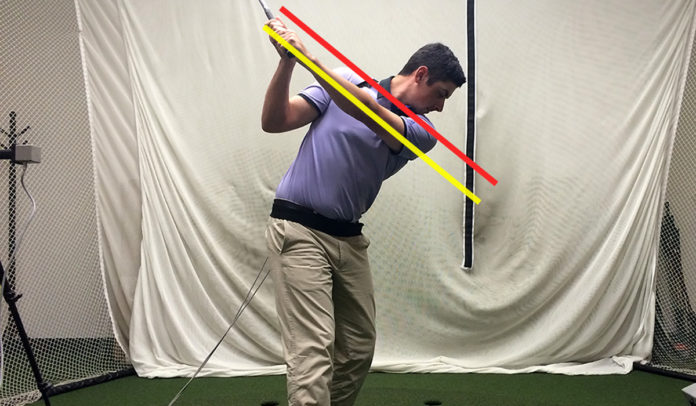Slicing the ball robs golfers of distance, solid contact, and directional control. This slice is typically caused by the club swinging over the top relative to the plane, often creating an outside-to-in club path.  Our post on The Common Slice helps illustrate this plane to path relationship further. In order to hit a draw (a shot that curves from right to left for a right handed player), the path of the club must be swinging inside-to-out with a clubface that is closed in relation to that path. A draw will add distance, improve your contact, and give you better directional control.
Our post on The Common Slice helps illustrate this plane to path relationship further. In order to hit a draw (a shot that curves from right to left for a right handed player), the path of the club must be swinging inside-to-out with a clubface that is closed in relation to that path. A draw will add distance, improve your contact, and give you better directional control.
An effective way to stop the over-the-top movement is to get your hands in the correct position at the top of the backswing. If your hands are too high at the top of the swing (shown in picture 1), you will lack sufficient depth with the club making it very difficult to hit a draw.
Notice the left arm’s relationship to the shoulder plane. Evaluating the position of the left arm relative to the shoulder plane helps the hands to get “deep” enough, or far enough behind the feet to allow the club to swing on the appropriate path. The left arm should be on, or slightly below, the shoulder plane at the top of the backswing to achieve the appropriate depth.  Picture 2 indicates the shoulder plane with a red line and the left arm position with a yellow line. When the left arm is in this position, achieving the path of the downswing needed to hit a draw is much easier.
Picture 2 indicates the shoulder plane with a red line and the left arm position with a yellow line. When the left arm is in this position, achieving the path of the downswing needed to hit a draw is much easier.
One of the trickiest aspects of changing the left arm position, however, is the feeling you must reach to achieve the correct position. When working on the change you will often need to feel like you are exaggerating the movement and feel that the left arm is well below the shoulder plane. You may even need to feel the left arm staying below the collar or buttons of your shirt. To practice this effectively you must use video to identify if the FEELING of your left arm position matches the REALITY of what you are actually doing.
If the left arm is higher than the shoulder plane this will create less depth in the backswing and likely set you up to swing the club over the top, resulting that dreaded slice.
To increase the depth of your swing and achieve the feeling you need to hit reliable draws, try a simple wall depth drill. Start by taking your golf stance with your rear against a wall and slowly start your backswing without a club. As you rotate, you are trying to touch the wall with your hands. Be sure that you do not lift your arms too high or it will make it difficult to touch the wall. Here’s a look at the wall drill in action:

If you continue to struggle with slicing the ball, talk to your local GolfTEC Coach.












Is this considered a one-plane swing and the top picture a two-plane swing? I believe Jim Hardy mentioned a one -plane swing can follow the shaft position at address or the the arm/shoulder plane.